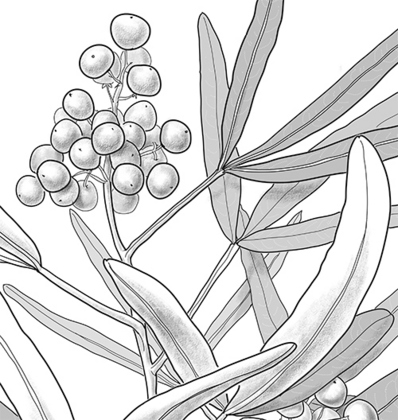Common name: Karee, African Sumac
Searsia lancea (L.f.) F.A.Barkley APNI* 
Description: Evergreen, dioecious shrub or small tree up to 9–12 m tall, glabrous; bole often twisted and crooked; bark surface dark grey to dark brown, rough, often irregularly fissured; twigs reddish brown, angular or slightly grooved, pendulous.
Leaves arranged spirally, 3-foliolate; petiole 2–7 cm long, slender but slightly winged near apex, grooved above; leaflets sessile, narrow-lanceolate, 7–24.5 cm long, 0.5–3 cm wide, cuneate at base, acute at apex, margins entire, thinly leathery, pinnately veined with numerous lateral veins.
Inflorescence an axillary or terminal, much-branched panicle up to 9 cm long, lax. Flowers unisexual, regular, usually 5-merous, greenish yellow; pedicel 2–3 mm long; calyx segments c. 0.5 mm long, obtuse; petals free, oblong, c. 1.5 mm long; stamens usually 5, free.
Fruit a depressed-globose drupe 4–6.5 mm in diameter, often slightly asymmetric, dull yellow to greyish or brown, with fleshy pulp.
Distribution and occurrence: Searsia lancea is indigenous in Zambia, Namibia, Botswana, Zimbabwe, South Africa and Lesotho. It is planted in America where it has become naturalised. This record from the South Far Western Plains of New South Wales is the first naturalised record for Australia.
NSW subdivisions: *NFWP, *SFWP
This plant has an aggressive root system and is hard to kill. Iit travels by sucker as well as seed.
Text by Louisa Murray Sep 2016
Taxon concept: Plant Resources of Tropical Africa : http://uses.plantnet-project.org/en/Searsia_lancea_(PROTA)
APNI* Provides a link to the Australian Plant Name Index (hosted by the Australian National Botanic Gardens) for comprehensive bibliographic data
***The AVH map option provides a detailed interactive Australia wide distribution map drawn from collections held by all major Australian herbaria participating in the Australian Virtual Herbarium project.
|


